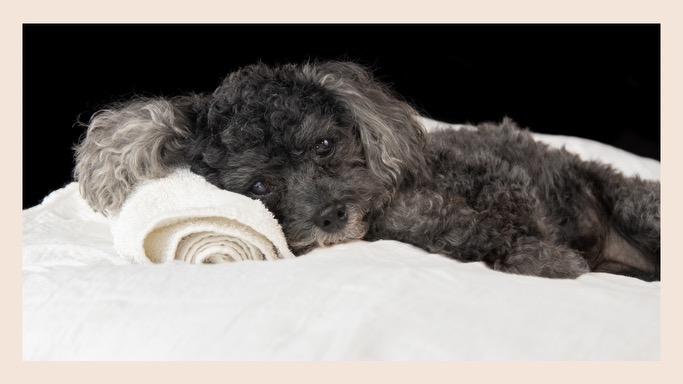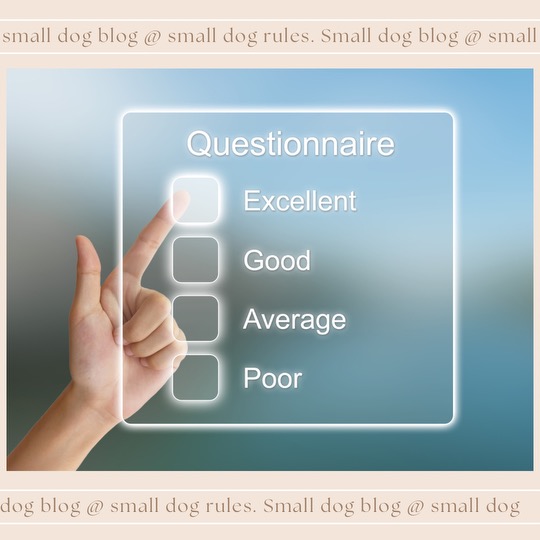1200 Words, 3 minute read. In this article, discover how to enhance your small dog’s well-being by measuring their canine quality of life. Explore effective tools to measure how your little dog is faring over time so you’ll never again wonder “is my small dog happy”?

Science Is Talking About Dog Happiness
I read veterinary journals as a hobby.
Clearly, I’m fascinating at cocktail parties.
And yes, my geeky leisure activity may well make me the most uninteresting person in the world. But I don’t care. In fact, my pastime doesn’t merely exercise my brain. It provides me with cutting-edge science and the evolved thinking on how humans can best live ethically with the amazing canines who grace our lives.
In short, my research-reading makes me a better dog parent…and a better steward of The Small Dog Rules.
My reading this past week brought me to a 2023 study in Animals reporting on the disconnect between what our veterinarians think we want…and what we actually want. But that disconnect isn’t what drew me to the article. The study’s secondary focus–on measuring canine quality of life in healthy dogs–is what grabbed my attention.
Canine Quality of Life and Small Dog Happiness
We all know (or at least we’re becoming aware) of the vital mind-body connection in humans. When it comes to our own health, we understand the ways in which our emotional outlook impacts our physical well-being.
It’s only logical to extend such thinking to our dogs as well. Their mental well-being impacts their physical wellness. A bored or depressed dog will withdraw, and our busy lives sometimes prevent us from noticing. And then the bout of boredom becomes habitual. They stop wanting to exercise or play, they either eat too much or too little, and before we know it, their minor mental slump morphs into physical manifestations.

How can we track our pups’ mental health?
In “Broadening the Veterinary Consultation: Dog Owners Want to Talk About More Than Physical Health,” 70% of owners expressed a need for at-home surveys to complete so they could better share their dogs’ mental well-being with their vet.
But it’s not just in speaking with our veterinarians that we need these tools.
So much of what we do at home to improve our small dogs’ happiness and quality of life can be enhanced if we’re armed with ways to measure that quality of life. And, not that you need any additional motivation, but the happier our small dogs are, the more joyful we will be. According to the American Veterinary Medicine Association, “the human-animal bond is a mutually beneficial and dynamic relationship between people and animals that is influenced by behaviors essential to the health and wellbeing of both”.
Using Quality of Life Questionnaires to Understand Small Dog Happiness
In other words, our small dogs’ quality of life is directly influenced by how we humans bond with them. And, the stronger our bond with our pups, the better it is for both them and us. Just imagine the difference it could make if we had the means to understand our dogs’ happiness and contentment beyond physical health signs.
It’s not just about spotting illnesses; it’s about understanding and addressing the emotional and cognitive aspects of our pets’ well-being.

How Do We Do That?
Well, in several ways. Most of you have likely heard of C-BARQ: the Canine Behavioral Assessment and Research Questionnaire. It’s widely considered “the” best tool for measuring canine cognitive function. In fact, according to a 2023 article in Discover Magazine, C-BARQ is fundamentally changing how pet owners can participate in scientific research and enhance their pups’ well-being.
Understanding why certain dogs act the way they do has significant implications, not just for our pets but also for working dogs and even for humans themselves. To learn more, since 2005, a project at the University of Pennsylvania School of Veterinary Medicine has been gathering information on dog behavior from tens of thousands of dog owners, building the most comprehensive database on canine behavioral traits in the world.
The Canine Behavioral Assessment and Research Questionnaire (C-BARQ) asks dog owners to spend about 15 minutes answering questions about how their dog responds in a range of everyday situations, along with information about the pup’s breed. The database currently contains information on more than 70,000 dogs, from over 300 breeds and crossbreeds. (There’s also a version for cats, called Fe-BARQ.)

Using C-BARQ to Enhance Small Dog Happiness
While C-BARQ was developed and is utilized most frequently by scientists studying dogs–they call it “crucial” for some of their work–we dog dads and moms can use the questionnaire in important ways as well:
- Understanding Our Dogs’ Personalities: We can recognize and appreciate the unique traits of our pups beyond breed stereotypes.
- Spotting Behavioral Issues: It helps us pinpoint specific behavioral concerns in our dogs, like fearfulness, aggression, or separation anxiety.
- Early Detection of Health Conditions: By highlighting associated behavioral changes, it gives us insights into potential health issues that may require veterinary attention.
- Tailoring Training and Environment: It can highlight our dogs’ individual temperaments so we can adapt our training methods and their schedules and environments.
- Improving Bond and Communication: It facilitates a deeper connection between us and our dogs by deciphering behavioral cues and communication signals more effectively.
- Contributing to Scientific Research: Our participation in the C-BARQ questionnaire contributes valuable data to ongoing scientific research, advancing our understanding of canine behavior.
- Promoting Our Dogs’ Well-Being: Ultimately, the insights gained empower us to advocate for our small dogs’ overall well-being and happiness, ensuring they live a fulfilling life.
Our Experience with C-BARQ as a Measure of Canine Quality of Life

I’d measured Phoebe’s mental state back in 2017 when she was only two years old. (You can see the scores, above). And then I’d forgotten all about doing so until I started reading about C-BARQ again this month.
When I re-evaluated her these seven years later, the change was striking. Her nonsocial fear had improved markedly, and she no longer has ANY “touch sensitivity,” but she’d developed moderate dog aggression and leash reactivity she never had as a young dog.
To have those two measures gives me significant information. I knew, for instance, Phoebe’s recent dog/leash aggression arose due to an incident last May when she and Scout were bum-rushed by a huge, loose dog. But if not for the C-BARQ data, I couldn’t be certain she’d never acted that way when she was very young.
And, while I’m still concerned about Phoebe’s nonsocial fear (it’s fear of fireworks), it gratified my heart to know it’s not as bad as it used to be.
I highly recommend you use the C-BARQ annually. Consider printing out the results to share with your veterinarian for addition to your pups’ medical chart. I’m going to be doing so.

Canine Health-Related Quality of Life Survey (HRQoL)
What Is the Canine HRQoL?
Another measure we can use to monitor our small dog’s well-being is the HRQoL.
Health-related quality of life (HRQOL) is all about looking at different aspects of a dog’s life affected by their health. It covers physical, mental/cognitive, emotional, and social well-being, showing how health impacts overall quality of life.
Who Uses the Canine Quality of Life Survey?
Researchers developed the Canine HRQOL for use in veterinary medicine, permitting vets to better communicate with pet parents regarding their pup’s health. You can read more about it in the October 2023 article “Development and Validation of a Canine Health-Related Quality of Life Questionnaire and a Human–Canine Bond Questionnaire for Use in Veterinary Practice”.
The tool isn’t widely used yet, but we can certainly help change that, while benefiting from it in two respects. First, it allows us to measure and quantify our own understanding of our pups at home. Second, just like the C-BARQ, if we bring it to our vet appointments, it ensures we have these important conversations with the professionals best able to interpret some of the data.
While we’re waiting for experts to put the questionnaire into a format that’s easy for us to use, I’m re-creating it in Google Sheets using a color-coded drop-down menu. (Researchers generously made it available to the public under a Creative Commons Share and Share Alike copyright).
I think the Google Sheets method will allow all of us easily to track changes in our pups. I’ll make it available as soon as I’ve tested it a couple of times.
What Other Canine Well-Being Questionnaires Are Out There?
I’ll do a more in-depth write-up of these, but in the meantime, know that if our pups have particular health challenges (including possible dementia or pain from injury or cancer), veterinarians can access several canine quality of life questionnaires to help assess our dogs’ well-being.
I’ve linked information about them, below.
Is My Small Dog Happy? Now We Know…

(I couldn’t resist including this picture of Phoebe and Scout on their human sister’s wedding day, as it shows how much fun it is when we can include pups in most of what we do–they’re just happy to be there. The wedding occurred toward the end of the COVID pandemic, and we hosted at our home. We had over fifty people, and Phoebe and Scout were so outgoing and polite, they almost upstaged the beautiful brides. But don’t tell them I said so :).
But, as usual, I digress. And yet, is it really a digression? If we want happy and engaged companions, we want to ace these canine quality of life tests. The good news is, we can study up. Let’s provide the right food, attention, exercise, and enrichment to ensure our small dogs live their best lives. If you want more tips on how to show your little pup just how much you care, read my article “How to Tell Your Dog You Love Them“. It’s the ultimate guide to being top dog in your pup’s heart!
You’ll Also Love
Leave a Reply
Your email address will not be published.





Excellent Article!
Thank you
Thanks for stopping by and letting me know you enjoyed it!